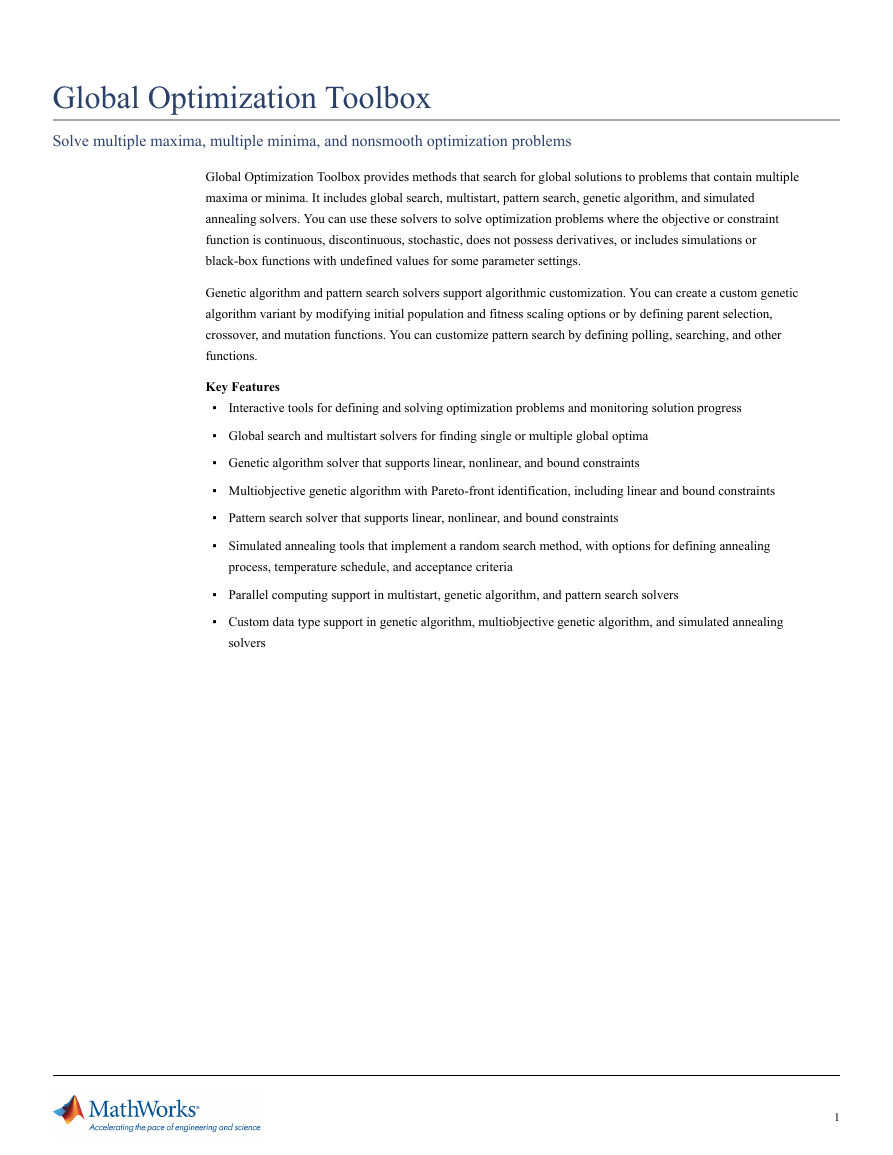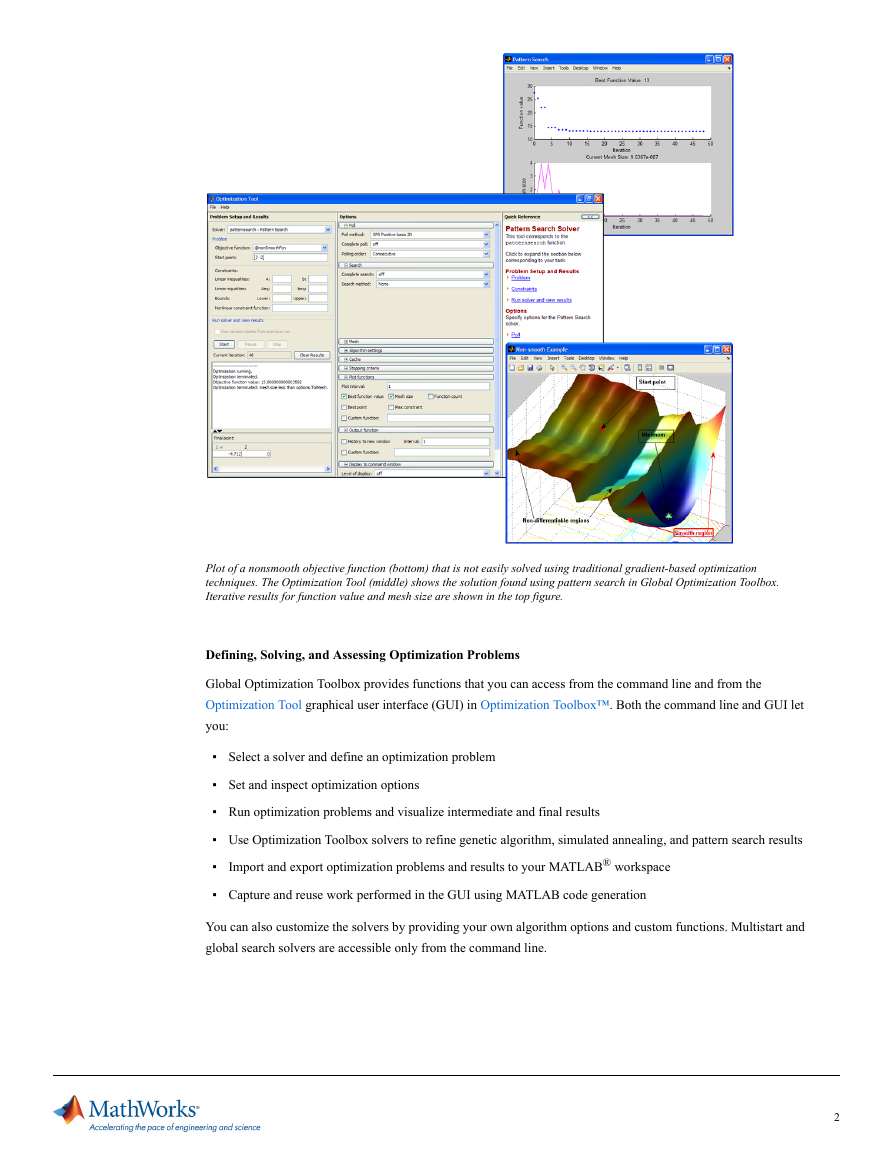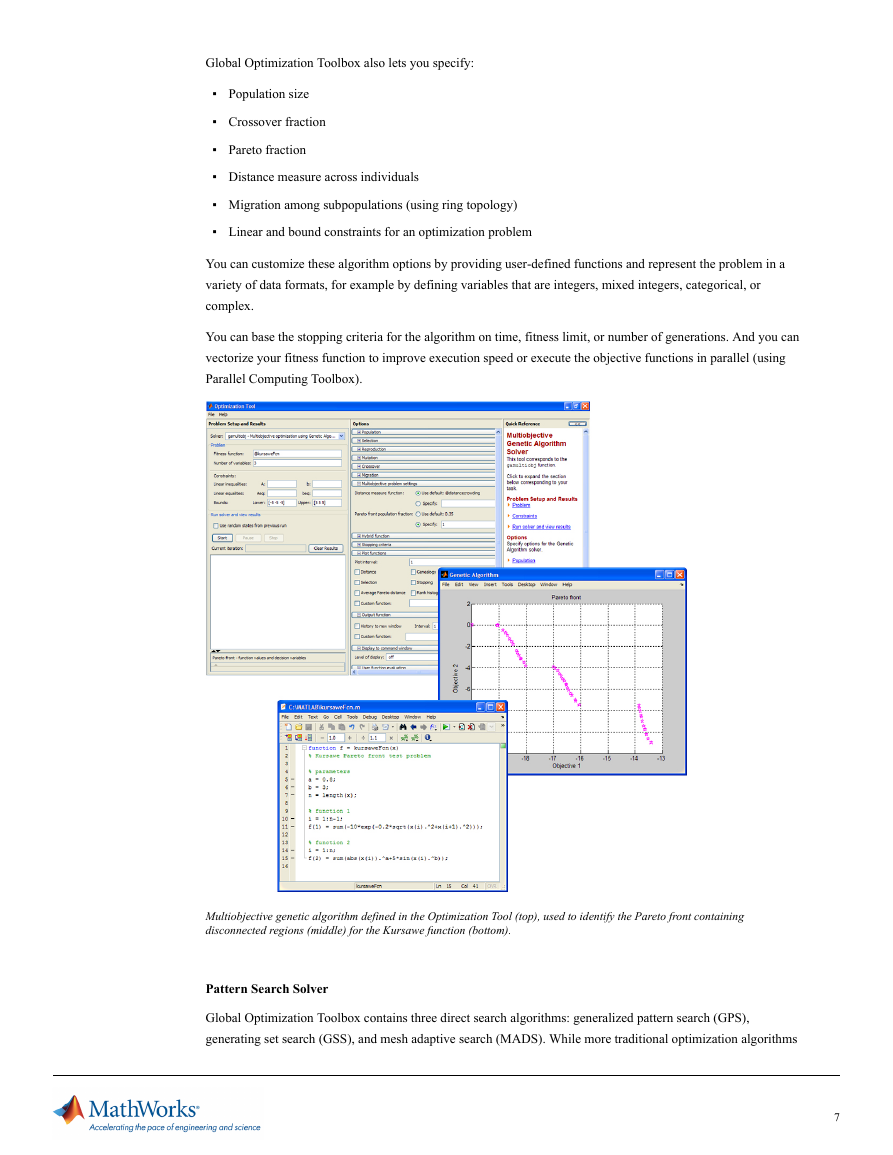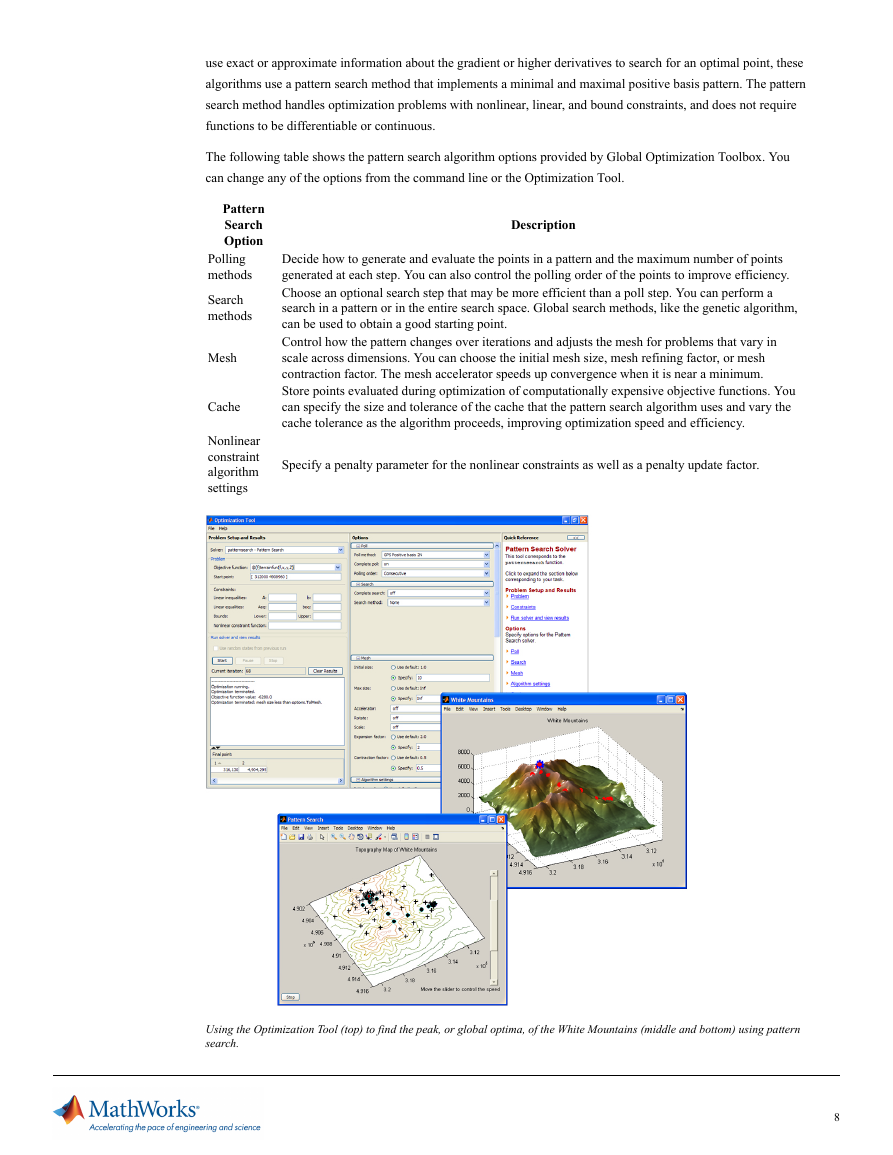Global Optimization Toolbox
Solve multiple maxima, multiple minima, and nonsmooth optimization problems
Global Optimization Toolbox provides methods that search for global solutions to problems that contain multiple
maxima or minima. It includes global search, multistart, pattern search, genetic algorithm, and simulated
annealing solvers. You can use these solvers to solve optimization problems where the objective or constraint
function is continuous, discontinuous, stochastic, does not possess derivatives, or includes simulations or
black-box functions with undefined values for some parameter settings.
Genetic algorithm and pattern search solvers support algorithmic customization. You can create a custom genetic
algorithm variant by modifying initial population and fitness scaling options or by defining parent selection,
crossover, and mutation functions. You can customize pattern search by defining polling, searching, and other
functions.
Key Features
▪
Interactive tools for defining and solving optimization problems and monitoring solution progress
▪ Global search and multistart solvers for finding single or multiple global optima
▪ Genetic algorithm solver that supports linear, nonlinear, and bound constraints
▪ Multiobjective genetic algorithm with Pareto-front identification, including linear and bound constraints
▪ Pattern search solver that supports linear, nonlinear, and bound constraints
▪ Simulated annealing tools that implement a random search method, with options for defining annealing
process, temperature schedule, and acceptance criteria
▪ Parallel computing support in multistart, genetic algorithm, and pattern search solvers
▪ Custom data type support in genetic algorithm, multiobjective genetic algorithm, and simulated annealing
solvers
1
�
Plot of a nonsmooth objective function (bottom) that is not easily solved using traditional gradient-based optimization
techniques. The Optimization Tool (middle) shows the solution found using pattern search in Global Optimization Toolbox.
Iterative results for function value and mesh size are shown in the top figure.
Defining, Solving, and Assessing Optimization Problems
Global Optimization Toolbox provides functions that you can access from the command line and from the
Optimization Tool graphical user interface (GUI) in Optimization Toolbox™. Both the command line and GUI let
you:
▪ Select a solver and define an optimization problem
▪ Set and inspect optimization options
▪ Run optimization problems and visualize intermediate and final results
▪ Use Optimization Toolbox solvers to refine genetic algorithm, simulated annealing, and pattern search results
▪
Import and export optimization problems and results to your MATLAB® workspace
▪ Capture and reuse work performed in the GUI using MATLAB code generation
You can also customize the solvers by providing your own algorithm options and custom functions. Multistart and
global search solvers are accessible only from the command line.
2
�
Visualization of Rastrigin’s function (right) that contains many local minima and one global minimum (0,0). The genetic
algorithm helps you determine the best solution for functions with several local minima, while the Optimization Tool (left)
provides access to all key components for defining your problem, including the algorithm options.
The toolbox includes a number of plotting functions for visualizing an optimization. These visualizations give you
live feedback about optimization progress, enabling you to make decisions to modify some solver options or stop
the solver. The toolbox provides custom plotting functions for both the genetic algorithm and pattern search
algorithms. They include objective function value, constraint violation, score histogram, genealogy, mesh size,
and function evaluations. You can show multiple plots together, open specific plots in a new window for closer
examination, or add your own plotting functions.
3
�
Run-time visualizations (right) generated while the function is being optimized using genetic algorithm plot functions selected in
the Optimization Tool (left).
Using the output function, you can write results to files, create your own stopping criteria, and write your own
application-specific GUIs to run toolbox solvers. When working from the Optimization Tool, you can export the
problem and algorithm options to the MATLAB workspace, save your work and reuse it in the GUI at a later time,
or generate MATLAB code that captures the work you’ve done.
MATLAB file of an optimization created using the automatic code generation feature in the Optimization Tool. You can export
an optimization from the GUI as commented code that can be called from the command line and used to automate routines and
preserve your work.
4
�
While an optimization is running, you can change some options to refine the solution and update performance
results in genetic algorithm, multiobjective genetic algorithm, simulated annealing, and pattern search solvers. For
example, you can enable or disable plot functions, output functions, and command-line iterative display during
run time to view intermediate results and query solution progress, without the need to stop and restart the solver.
You can also modify stopping conditions to refine the solution progression or reduce the number of iterations
required to achieve a desired tolerance based upon run-time performance feedback.
Global Search and Multistart Solvers
The global search and multistart solvers use gradient-based methods to return local and global minima. Both
solvers start a local solver (in Optimization Toolbox) from multiple starting points and store local and global
solutions found during the search process.
The global search solver:
▪ Uses a scatter-search algorithm to generate multiple starting points
▪ Filters nonpromising start points based upon objective and constraint function values and local minima
already found
▪ Runs a constrained nonlinear optimization solver to search for a local minimum from the remaining start
points
The multistart solver uses either uniformly distributed start points within predefined bounds or user-defined start
points to find multiple local minima, including a single global minimum if one exists. The multistart solver runs
the local solver from all starting points and can be run in serial or in parallel (using Parallel Computing
Toolbox™). The multistart solver also provides flexibility in choosing different local nonlinear solvers. The
available local solvers include unconstrained nonlinear, constrained nonlinear, nonlinear least-squares, and
nonlinear least-squares curve fitting.
Using Global Search for Optimization Problems 3:57
Find local and global minima of the peaks function.
Using MultiStart for Optimization Problems 4:16
Find the best-fit parameters for an exponential model.
Genetic Algorithm Solver
The genetic algorithm solves optimization problems by mimicking the principles of biological evolution,
repeatedly modifying a population of individual points using rules modeled on gene combinations in biological
reproduction. Due to its random nature, the genetic algorithm improves your chances of finding a global solution.
It enables you to solve unconstrained, bound-constrained, and general optimization problems, and it does not
require the functions to be differentiable or continuous.
The following table shows the standard genetic algorithm options provided by Global Optimization Toolbox.
Step
Creation Uniform, feasible
Genetic Algorithm Option
5
�
Genetic Algorithm Option
Rank-based, proportional, top (truncation), shift linear
Step
Fitness
scaling
Selection Roulette, stochastic uniform selection (SUS), tournament, uniform, remainder
Crossover Arithmetic, heuristic, intermediate, scattered, single-point, two-point
Mutation Adaptive feasible, Gaussian, uniform
Plotting Best fitness, best individual, distance among individuals, diversity of population, expectation of
individuals, max constraint, range, selection index, stopping conditions
Global Optimization Toolbox also lets you specify:
▪ Population size
▪ Number of elite children
▪ Crossover fraction
▪ Migration among subpopulations (using ring topology)
▪ Bounds, linear, and nonlinear constraints for an optimization problem
You can customize these algorithm options by providing user-defined functions and represent the problem in a
variety of data formats, for example by defining variables that are integers, mixed integers, categorical, or
complex.
You can base the stopping criteria for the algorithm on time, stalling, fitness limit, or number of generations. And
you can vectorize your fitness function to improve execution speed or execute the objective and constraint
functions in parallel (using Parallel Computing Toolbox).
Optimal Component Selection Using the Mixed-Integer Genetic Algorithm 5:25
Use the mixed-integer genetic algorithm to solve an engineering design problem.
Multiobjective Genetic Algorithm Solver
Multiobjective optimization is concerned with the minimization of multiple objective functions that are subject to
a set of constraints. The multiobjective genetic algorithm solver is used to solve multiobjective optimization
problems by identifying the Pareto front—the set of evenly distributed nondominated optimal solutions. You can
use this solver to solve smooth or nonsmooth optimization problems with or without bound and linear constraints.
The multiobjective genetic algorithm does not require the functions to be differentiable or continuous.
The following table shows the standard multiobjective genetic algorithm options provided by Global Optimization
Toolbox.
Step
Multiobjective Genetic Algorithm Option
Rank-based, proportional, top (truncation), linear scaling, shift
Creation Uniform, feasible
Fitness
scaling
Selection Tournament
Crossover Arithmetic, heuristic, intermediate, scattered, single-point, two-point
Mutation Adaptive feasible, Gaussian, uniform
Plotting Average Pareto distance, average Pareto spread, distance among individuals, diversity of population,
expectation of individuals, Pareto front, rank histogram, selection index, stopping conditions
6
�
Global Optimization Toolbox also lets you specify:
▪ Population size
▪ Crossover fraction
▪ Pareto fraction
▪ Distance measure across individuals
▪ Migration among subpopulations (using ring topology)
▪ Linear and bound constraints for an optimization problem
You can customize these algorithm options by providing user-defined functions and represent the problem in a
variety of data formats, for example by defining variables that are integers, mixed integers, categorical, or
complex.
You can base the stopping criteria for the algorithm on time, fitness limit, or number of generations. And you can
vectorize your fitness function to improve execution speed or execute the objective functions in parallel (using
Parallel Computing Toolbox).
Multiobjective genetic algorithm defined in the Optimization Tool (top), used to identify the Pareto front containing
disconnected regions (middle) for the Kursawe function (bottom).
Pattern Search Solver
Global Optimization Toolbox contains three direct search algorithms: generalized pattern search (GPS),
generating set search (GSS), and mesh adaptive search (MADS). While more traditional optimization algorithms
7
�
use exact or approximate information about the gradient or higher derivatives to search for an optimal point, these
algorithms use a pattern search method that implements a minimal and maximal positive basis pattern. The pattern
search method handles optimization problems with nonlinear, linear, and bound constraints, and does not require
functions to be differentiable or continuous.
The following table shows the pattern search algorithm options provided by Global Optimization Toolbox. You
can change any of the options from the command line or the Optimization Tool.
Pattern
Search
Option
Polling
methods
Search
methods
Mesh
Cache
Nonlinear
constraint
algorithm
settings
Description
Decide how to generate and evaluate the points in a pattern and the maximum number of points
generated at each step. You can also control the polling order of the points to improve efficiency.
Choose an optional search step that may be more efficient than a poll step. You can perform a
search in a pattern or in the entire search space. Global search methods, like the genetic algorithm,
can be used to obtain a good starting point.
Control how the pattern changes over iterations and adjusts the mesh for problems that vary in
scale across dimensions. You can choose the initial mesh size, mesh refining factor, or mesh
contraction factor. The mesh accelerator speeds up convergence when it is near a minimum.
Store points evaluated during optimization of computationally expensive objective functions. You
can specify the size and tolerance of the cache that the pattern search algorithm uses and vary the
cache tolerance as the algorithm proceeds, improving optimization speed and efficiency.
Specify a penalty parameter for the nonlinear constraints as well as a penalty update factor.
Using the Optimization Tool (top) to find the peak, or global optima, of the White Mountains (middle and bottom) using pattern
search.
8
�
















 2023年江西萍乡中考道德与法治真题及答案.doc
2023年江西萍乡中考道德与法治真题及答案.doc 2012年重庆南川中考生物真题及答案.doc
2012年重庆南川中考生物真题及答案.doc 2013年江西师范大学地理学综合及文艺理论基础考研真题.doc
2013年江西师范大学地理学综合及文艺理论基础考研真题.doc 2020年四川甘孜小升初语文真题及答案I卷.doc
2020年四川甘孜小升初语文真题及答案I卷.doc 2020年注册岩土工程师专业基础考试真题及答案.doc
2020年注册岩土工程师专业基础考试真题及答案.doc 2023-2024学年福建省厦门市九年级上学期数学月考试题及答案.doc
2023-2024学年福建省厦门市九年级上学期数学月考试题及答案.doc 2021-2022学年辽宁省沈阳市大东区九年级上学期语文期末试题及答案.doc
2021-2022学年辽宁省沈阳市大东区九年级上学期语文期末试题及答案.doc 2022-2023学年北京东城区初三第一学期物理期末试卷及答案.doc
2022-2023学年北京东城区初三第一学期物理期末试卷及答案.doc 2018上半年江西教师资格初中地理学科知识与教学能力真题及答案.doc
2018上半年江西教师资格初中地理学科知识与教学能力真题及答案.doc 2012年河北国家公务员申论考试真题及答案-省级.doc
2012年河北国家公务员申论考试真题及答案-省级.doc 2020-2021学年江苏省扬州市江都区邵樊片九年级上学期数学第一次质量检测试题及答案.doc
2020-2021学年江苏省扬州市江都区邵樊片九年级上学期数学第一次质量检测试题及答案.doc 2022下半年黑龙江教师资格证中学综合素质真题及答案.doc
2022下半年黑龙江教师资格证中学综合素质真题及答案.doc